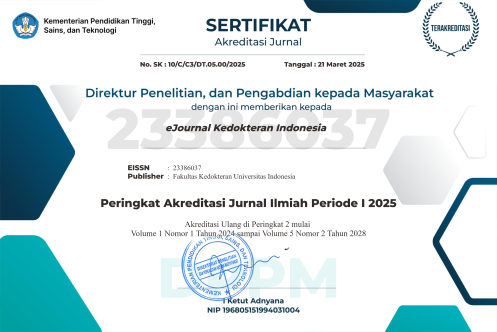Submissions
Submission Preparation Checklist
As part of the submission process, authors are required to check off their submission's compliance with all of the following items, and submissions may be returned to authors that do not adhere to these guidelines.- The submission material has not been previously published and the author(s) have not transferred elsewhere any rights of the article.
- The author(s) have ensured the manuscript complies with the eJKI instructions for authors and the template.
- The submission file is in Microsoft Word document file format.
- No personal information (description, photograph, or pedigree) has been disclosed by the author(s) that may make the identity of the study participant(s) recognizable. If photographs of the study participant(s) are essential and indispensable as scientific information, the author(s) have received consent in writing, and this has been clearly stated.
- In the case of experimenting on humans, the author(s) have certified that the process of the research is in accordance with the ethical standards of the Helsinki declaration and those of the domestic and foreign committees that preside over human experiments. In the case of experimenting on animals, the author(s) have certified that the domestic and foreign guidelines related to experiments on animals in a laboratory have been followed. The research ethics protocol approval number must be written down.
- If photographs, figures or tables have been reproduced from other journals or books, the author(s) have received consent from the author or editor of the original source.
- The author fills out and signs the Author(s) Statement Form and submits it with the article.
Copyright Notice
Authors who publish with eJKI agree to the following terms:
- Authors retain copyright and grant eJKI right of first publication with the work simultaneously licensed under a Creative Commons Attribution License CC BY-SA that allows reusers to distribute, remix, adapt, and build upon the material in any medium or format, so long as attribution is given to the creator. The license allows for commercial use. If you remix, adapt, or build upon the material, you must license the modified material under identical terms.
- Authors are able to enter into separate, additional contractual arrangements for the non-exclusive distribution of the journal’s published version of the work (e.g., submit it to an institutional repository or publish it in a book), with an acknowledgment of its initial publication in this journal.
- Authors are permitted and encouraged to post their work online (e.g., in institutional repositories or on their website) prior to and during the submission process, as this can lead to productive exchanges, as well as earlier and greater citation of published work (see The Effect of Open Access).
Privacy Statement
The names and email addresses entered on this site will be used exclusively for the stated purposes of this journal and will not be made available for any other purpose or to any other party.



